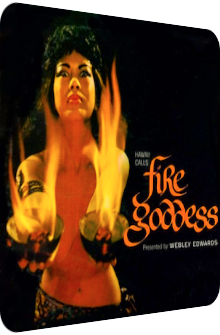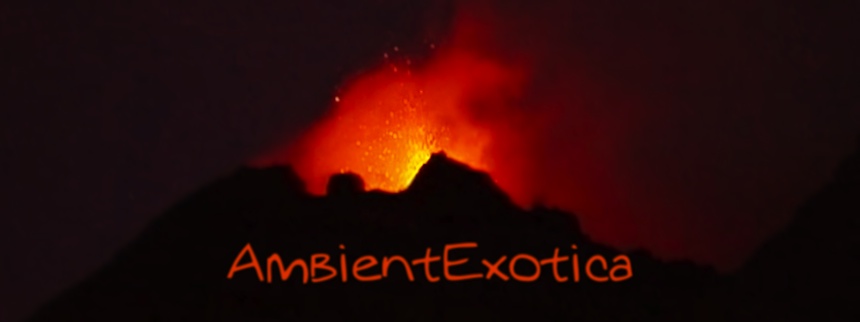
Webley Edwards Presents
Fire Goddess
1958
If there is one LP that teaches even the diehard Exotica fan a lesson, it either has to derive from radio luminary Webley Edward‘s (1902–1977) famous album series Hawaii Calls or the equally successful battery Webley Edwards Presents…, recorded on site in Honolulu, not in some carpeted studio in Nashville, New Jersey or Bakersfield. These albums only feature Hawaiian instruments, singers and songs, nothing else. They are not your typical presents you bring home as a tourist, although they are all released on the big mothership Capitol Records.
Unsurprisingly, this review is about the album Fire Goddess which is released in 1958 during the peak of Edwards’ career who saw the general interest in his radio show increase in the heyday of Exotica. Comprising 14 tracks as well as 16 musicians, singers and soloists, Fire Goddess is dedicated to the legend of said fire goddess Pele, and if that name rings a bell, yes indeed, The Legend Of Pele is also the name of Arthur Lyman’s quasi-concept album from 1959. If you would like to know more about this myth, head over to that review, as the liner notes of Lyman's LP are much more detailed.
What do you expect from a Hawaiian album? Steel guitars and ukuleles aplenty? Yup, who doesn’t, and these are indeed on board. But there is much more to Fire Goddess whose compositions are regularly divided into two parts. The first one is loaded with mantra-like chants and sparse instrumentation, whereas the second part features the archetypical ukuleles and steel guitars. Both markers are characteristics of Hawaiian music, but Hollywood channeled only the latter, more euphonious ingredients into the ears of listeners worldwide. Here on Fire Goddess, one gets to hear the definitive music of Hawaii. Not even Sam Makia’s and Frank Hunter‘s Hawaii: The Fabulous 50th State (1959) is this accurate due to its orchestral string washes. Read on to know which particular lessons Webley Edwards’ album taught me and what else there is to know about it.
The opener Fire Goddess is not often cited by Exotica fans as a truly inspiring tune, let alone a gold standard, but once this traditional piece is arranged by Webley Edwards, it turns into something beautiful, the reasons being close at hand: this is a live recording on site, with the waves peacefully washing ashore and the birds joyously chirping for a whole minute; talk about wasting precious time on an Exotica LP! Soon enough, the Hawaii Chorus sings mantra-like chants in Hawaiian, with their preaching lead singer cautiously accompanied by hardwood sticks called la-au and a double bass aorta. Everything feels like a true Pagan procession, an atmosphere not often emitted in that glitzy genre.
Up next is John Kalapana’s Canoe Song aka Ohinemutu which features the prelude of a chanting precentor whose words are echoed by a male choir, but soon focuses on another choir of hula girls which is accompanied by steel guitars and ukuleles. This is the first sign of the sun-dappled things to come, although Charles E. King’s following Tapa Dance seemingly absorbs the mood of the opener at first by only sporting a maraca-accentuated and double bass-driven rhythm structure, but soon enough transforms into a multifaceted piece comprising of shell drums, mixed choirs and moments of contemplation where the vocals fade into the black distance.
While the traditional Flame Dance is a soothing piece that only features a female singer and a Hawaiian bamboo pipe, Makani Luika’s Knife Dance is the first arrangement that makes merciless use of the bone-crushing drums which drone through the mystical arcanum that is only illumined by shell percussion and a sun-dried Hawaiian guitar. The last 20 seconds are mirthful and frantic, but the male vocals throughout the piece truly take the listener to strange islands. John Kahale and Charles E. King’s Forbidden Waters (Wai Kapu) form the fitting counterpart to the previously nocturnal aura via a Hawaiian vibrapharp and warm ukulele strata in-between the choir, whereas Webley Edwards’ own instrumental Sharkskin Drums feature six types of these devices at the beginning, only to then round things off with typically warped steel guitar licks.
Side B opens with the surprisingly Country-compatible Beauty Hula, a mountainous ditty with clicking la-au sticks, singing men and guitar layers en masse. No surprise, for Johnny Mercer's quill was involved in this original piece by John K. Almeida. Whereas Thoughts Of Love by John Kalapana launches with a gorgeous mystique due to the vibraharp and a flute-like pu conch which then make room for the expected choir-backed ukulele and steel guitar amalgamation, Hawaiian Bamboos exclusively relies on bamboo wands and similar devices and amends the soothing piece with "a cappella" preaches and echoes. R. Alex Anderson’s following stupefying instrumental Temple Dance is the best piece of side B due to its Far Eastern prelude which is supercharged with temple gongs and pentatonic guitars before returning to Polynesian lands with super-silkened steel guitars and the distant reverberation of the gong. This is not a dance rather than a meditative composition.
John Kalapana’s Chant Of The Islands meanwhile lives up to the title qua its preached vocals that are only accompanied by murky drums. As usual, the scenery is almost completely abandoned seconds later thanks to a warped strumming on the steel guitar and a mixed choir awash with light. The drums, however, retain their impetus and strength. James Hololio’s The Old Church is the last rendition of the album, featuring a stable downbeat, ecclesial chants and twinkling vibrapharp droplets in the right moments, all the while the finale Pele, Fire Goddess lets the album come full circle; the simulation of an exploding volcano launches the divine apotheosis, with the hardwood sticks and double bass scents wafting around the solemn choir. One final thunder, and ocean waves as well as birds return before the album fades out for good.
Hawaiian in the true sense of the term, Webley Edward’s Fire Goddess is an ode to both the divine myth and the original point of origin of traditional Polynesian music of the Golden Islands. In case you have not noted already, this particular artifact of the Webley Edwards Presents… series teaches me a bold lesson in two ways, and this is why I come back to it often, although not as often as I wish to. The level of detail is amazing, the researched use of strictly Hawaiian instruments is another boon, and the large choir covers all emotional ranges, from short bursts of threnody over awe to warmhearted joy. Anyway, the aforementioned lesson comes down to this: firstly, it shows me that I lack even the basic skills in understanding the presented material, with the language being only one obstacle. Many colorful traditions of Hawaii are embroidered here, all of them either leading to Pele or being spawned by her. The album is created for a North American audience, but does not succumb to softening the darker undertones or lessening the amount of airtime the choir enjoys.
This implies the second lecture this album tells: the vast majority of Hawaiian albums and Hapa Haole artifacts only concentrates on the ukuleles, steel guitars and maybe a few drums, but does not depict the level of authenticity Webley Edwards’ productions showcase. And it is here where I realize my guilt, even though I had yet to be born during Edwards’ lifespan! As much as I enjoy Fire Goddess, I have to admit that Arthur Lyman’s take on that legend is much better tailored to my needs. Edwards’ vision is mercilessly authentic, with not even a bongo or conga injected, as these are not instruments of Hawaiian origin. I can only speak for myself, for the very skills I lack, other people possess aplenty, so it is hence clear that I like the Exotica material off the LP best, for instance the superb Temple Dance and Knife Dance as well as Edwards’ Sharkskin Drums. If you want an album that neglects the tourist’s aspiration and really focuses on how things are in 1958, not how they could be, Fire Goddess is your very best choice. There are quite literally no strings attached except Hawaiian ones. Available on vinyl and a remastered download version on Amazon MP3, iTunes and cohorts.
Exotica Review 381: Webley Edwards Presents – Fire Goddess (1958). Originally published on Oct. 11, 2014 at AmbientExotica.com.
